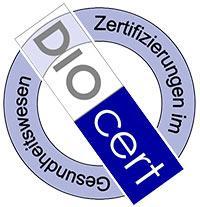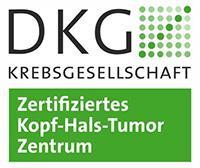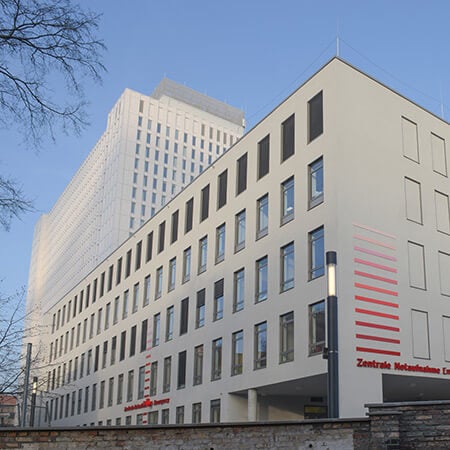Tracheal stenosis is usually a post-traumatic disease. It is associated with the growth of scar tissue inside the trachea after prolonged intubation and mechanical ventilation. Both open surgery and endoscopic procedures can be used for treatment. Prior to treatment, patients are carefully diagnosed: computed tomography and bronchoscopy are performed to assess the severity of stenosis, its cause, and the severity of the respiratory failure.
Content
- Endoscopic treatment
- Surgical treatment
Stenosis is usually treated with endoscopic procedures: balloon dilatation, laser intervention, and prosthetic repair. Such operations are associated with a low risk of complications and allow reliable restoration of the tracheal lumen.
You can undergo treatment at the University Hospital of the Ludwig Maximilian University of Munich, the University Hospital Ulm, the University Hospital Frankfurt am Main.
Please leave your request on the Booking Health website, and we will select the most suitable clinic and doctor for you, make an appointment, help collect the necessary documents, and arrange flights and accommodation. During your treatment in Germany, you will be accompanied by a medical interpreter, and a personal coordinator will be in constant contact with you.
Endoscopic treatment
Endoscopic treatment of tracheal stenosis involves the use of a laser, balloon dilatation, bougienage, and prosthetic repair (stenting). These procedures are used as basic or additional, on a scheduled or emergency basis.
Bougienage and dilation
Bougienage is the simplest and fastest method of treatment, providing a quick restoration of the normal tracheal lumen. The procedure is carried out with special dilators. They are introduced into the tracheal lumen, stretching the walls. The diameter of the dilators after each injection is increased by 1-2 mm. To restore respiratory function in adults, a diameter of at least 12 mm is required.
Balloon dilatation is a similar procedure, but the trachea is dilated with a balloon, which inflates and increases the diameter. This manipulation is technically more perfect. It is more effective and safer than bougienage. The balloon can achieve pressure of up to 15 atmospheres, which makes it possible to destroy even dense scars of great length. The risk of injury is lower than with bougienage. After the procedure, the cartilaginous half-rings are lost, but the resulting scar tissue is dense enough to keep the tracheal lumen open during breathing.
Both procedures are a temporary solution to the problem. Long-term results can be achieved in only 15% of patients, while the rest develop recurrent stenosis. A favorable prognosis factor is that the length of the stenosis is not more than 1 cm. If the length is longer, the person will need an additional operation, and bougienage or balloon dilatation only helps stabilize the patient's condition at the stage of preparation for surgery.
Balloon dilatation can be performed according to emergency indications: for decompensated tracheal stenosis. At this point, its diameter, as a rule, narrows to 5 mm or less. The bougienage or dilatation procedure begins immediately after a person is admitted to the clinic. The scheduled dilatation is performed when the diameter of the tracheal lumen is more than 5 mm.
Bronchoscopic laser intervention
It is used for a clearly formed fibrous ring, up to 2.5 cm long, as well as for cicatricial obliteration of the tracheal lumen above the tracheostomy (the hole that goes to the front surface of the neck). This is a scheduled procedure.
With the help of the laser, doctors dissect the scar tissue in the radial direction, to a depth of up to 2 mm. Laser exposure does not reach the boundaries of the tracheal wall. Laser incisions are usually made in 3-4 directions, depending on the shape of the fibrous ring. Doctors try to avoid laser exposure to the posterior tracheal wall so as not to damage the esophagus.
The laser procedures may be followed by other manipulations. For example, tracheal bougienage and the introduction of an endoprosthesis.
Like balloon dilatation or bougienage, the laser procedure provides a temporary effect. It keeps for 2-4 weeks. Therefore, the manipulation is used as an independent method when the length of cicatricial stenosis is up to 1 cm. If the length is greater, an additional prosthetic repair is required.
Tracheal prosthetic repair (stenting)
This is the insertion of a tube that keeps the trachea open. It stabilizes the tracheal walls after the restoration of the lumen with a laser or balloon. Doctors in Germany use the very latest types of endoprostheses, which:
- provide adequate lung ventilation;
- keep the tracheal lumen open;
- are made of biologically inert material that does not cause inflammation;
- are easily inserted and, if necessary, easily removed from the trachea;
- do not interfere with the removal of mucus.
The shape of the stents can be linear, T-shaped, and bifurcated. The most commonly used are linear. They are effective for cicatricial stenosis, which is localized 2 cm below the vocal folds of the larynx. The standard width of the prosthesis is 16 mm, although smaller diameters, up to 14 mm, can be used in women of small stature. The standard length of the inserted endoprosthesis is plus 1-1.5 cm to the length of the cicatricial stenosis.
As for the material of manufacture, the endoprosthesis can be metal, silicone, polyamide, as well as metal with a silicone coating.
T-shaped prostheses appeared before all. They are two perpendicular smooth tubes. Such prostheses are placed in patients with a tracheostomy, as well as for stenoses that spread to the larynx or laryngotracheal junction. As a rule, the diameter of such prostheses is 13-15 mm.
Bifurcated prostheses are rarely used. They are placed in the bifurcation zone of the trachea if the scars are localized in this area.
Endoprosthesis is not placed permanently. After 1-2 years, dense scar tissue can form in the trachea, which creates a reliable frame. If the tracheal lumen exceeds 1 cm, this is sufficient for normal breathing. Therefore, the stent is removed. Patients in whom the zone of cicatricial stenosis does not exceed 1.5 cm are more likely to get rid of the prosthesis.
Surgical treatment
In severe cases, one has to resort to surgical resection of the trachea (its partial removal). Doctors remove the scarred area and form an anastomosis to restore the integrity of the airways.
This is a complex operation that should be performed in a specialized center. The risk of complications is very different in different countries and clinics: from 9 to 45%. Major complications: anastomotic leak and repeated development of stenosis.
To undergo diagnostics, treatment of tracheal stenosis in Germany, and rehabilitation, you are welcome to use the services of the Booking Health company. On the website, you can find out the cost of medical services. You can compare how much is the price for treatment in different clinics in Germany in order to book a medical care program at favorable prices. The specialists of the Booking Health company will help you choose the most suitable clinic and organize your trip.
Authors:
The article was edited by medical experts, board certified doctors Dr. Nadezhda Ivanisova and Dr. Sergey Pashchenko. For the treatment of the conditions referred to in the article, you must consult a doctor; the information in the article is not intended for self-medication!
Sources:
MedlinePlus
Sience Direct
The Lancet




















